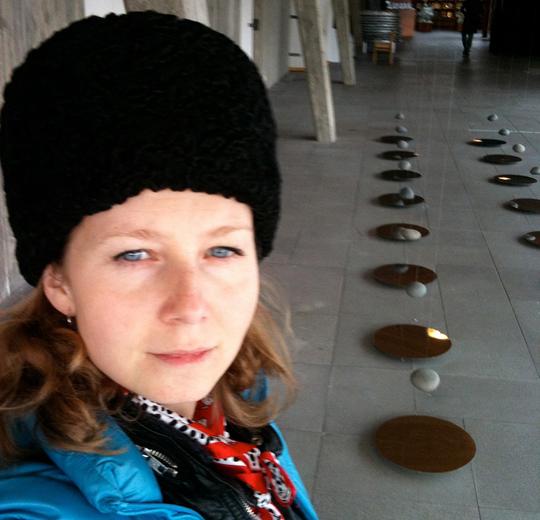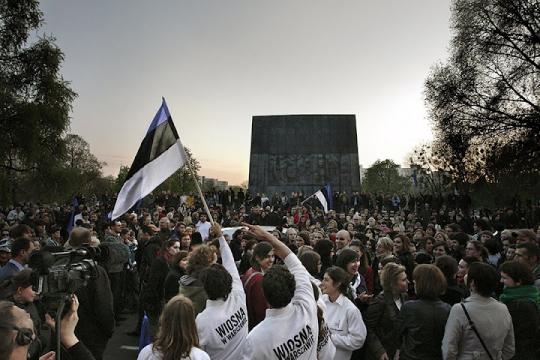Have you met... Joanna Warsza
Have you met... Joanna Warsza

In a little over a week, the long-expected and controversial 7th edition of Berlin Biennale will open its doors at KunstWerke, presumably adding more and more virtual pages of vivid criticism to the many that had already been written.
Whenever I read the name of main curator Artur Żmijewski, it is always extremely close -in centimeters and meaning- to the adjectives “radical”, “controversial”, “provocative”, and so on, in what we could call the semantic field of the upcoming Biennale. But his name is also linked to the Applied Social Arts Manifesto. Convinced than art trascends the mere object and should focus on the intellectual discourse, he appointed curator and artist Joanna Warsza to work with him co-curating a show that seems to be symptomatic of the latests social events that have hit the world as we know it.
Their alternative way of conceiving the exhibition space as a platform for political statement is attracting many eyes on the subject. On the one hand, all this purpose still seems to be quite abstract for those who are impatiently wondering about the full listing of artists names, while on the other, some certain activist sectors don't fully agree with these ideas and are even talking about sabotaging the biennial. Not to mention the infamous Book Action... that aroused the whole debate around the freedom of speech, and the possible resemblance of this action with some infamous events in the recent history of Germany.
How can art change politics and evoke real effects in our society...?. Feeling especially concerned about the subject that the 7. Berlin Biennale embodies, I met Joanna Warsza at KunstWerke for a talk about their curatorial works and other things that came along the way.
Let's start from the very beginning. How did you meet Artur and end up on board of the curatorial team yourself?
I contacted him for the first time in 2010, when I wanted to work with an actor from one of his films. I knew that he was a difficult person, so I was expecting a casual, maybe not pleasant meeting, but we ended up having a really nice conversation. After that, we stayed in touch for a while and continued to talk sometimes. Then in January 2011, I got a one-sentence email in which he invited me to join the project as soon as possible. I still find surprising the fact that he trusted me even though we never worked together before.
You work as a team dealing with collectives and groups. How is that?
Yes, we work as a team and we also list the Russian collective Voina as associated curators. However they have never been to KW, they just continue working on their anti-govermental protests and on-ground resistance in Russia. Through our alliance their actions are again legitimized as art and they are legitimized as artists. We are also working with large collectives such as Occupy, we invited the groups who incited the shift of 2011 to make a parallel Biennale on the ground floor of KW, to advocate their ideas. It is an anti-curated space. We also work with Berlin-based think tank of artists and activists like the Center for Political Beauty, who look for moments of art in politics, or Mosireen from Egypt, who organizes what they call 'an image resistance' - initiatives like Tahrir cinema - to make people realize about the media manipulation and strategies.
Why did you decided to make an open call?
Artur Żmijewski announced an open-call before I joined the team. One of the reasons was to see how many people are interested in the cross-over of art and politics. If you get 5000 applications, you might think that all of them are. We decided to deal with all that material, to see the artists as part of the network, as social and political entities. We invited media activist Pit Schultz to reflect on the data. He inciated the online platform Artwiki, where artist can edit their profiles. This platform aims at privileging other then market-oriented representation in the internet. It has become a digital venue and will be launched on April 23rd and will last longer than the Biennale itself, hopefully for many years. But if you ask about our research I can tell you that we don't really do studio visits. We rather followed the news, and went to the places where important political or social events were taking place and looked how artists and culture producers responded to them.
You quote Okwui Enwezor and his idea of a Biennial (Biennales are the platforms for a real creative force and prompt curators to draw from within preexisting cultural and geographical loam). There's something inextricably utopic in this. Does it really sums up your goals, or better put, your mission?
I quoted him when I was doing a project at the Biennale de Belleville - Belleville is a district in Paris where a group of artists and curators decided to do a Biennale. I looked upon this extremely heterogenous district as potential readymade for a model of Biennale with national pavilions.The famous chinese restaurant Le President became Chinese pavilion, Niemeyer building -the site of the French communist party- a Brasilian pavilion- and a local super market the American pavilion. I used the infrastructure of the city to reflect on the local impact of this 'new community biennale' but also upon the Biennalisation at large, the dichotomy between the art and its urban, social and business effects. I definitely follow Enwezor anti-entertainment direction of Biennale construction, but I have to admit that we are probably more confrontative. We are not only showing art that intends to save the world.

Did you understand this as an exhibition about contemporary thoughts on politics or an attempt of political action itself?
The basic question for the research and exhibition was "how can art act for real", how can it be performative? I know, sounds like an avant-garde claim, but seems more than appropriate in our times. We feel the world doesn't need another Biennale as usual, maybe what is needed is an art strike from gallery weekends, dinners and deals. We rather try to make and represent the same scope of conflicts and issues going on in the society: (e.g. underrepresentation of Palestinian cause in the German debate, fear of hegemony of the church in the third world, discussion on controversial term of "expulsions of German population after World War II" and politics of memory, the questions about expanding the democratic field or exploitation of artists). Art is not a solution, is in fact a part of the problem.
What are the most common aesthetics generated from an artistic response that comes from the activism?
Well, pure aesthetics is not our criteria, but it also counts. The aesthetic judgement is to be done by the audience. A very important point for us is to show a parliament of opinions, not mere producers of aesthetic products. I still don't even know much about the formal aspects of the projects that will be presented at Berlin Biennale. In some cases we are also exhibiting things which won't be consider art by many people: like a billboard from a mobile company in Egypt that cut the connections during the revolution and monopolises on the image of the gathering people today.
KW has a strong identity, somehow that must be affecting the corporate image of a political Biennale, or even affecting the aesthetics of resistance. What degree of control do you have upon the desgin?
As far as I know, this institution is widely known for their most provocative exhibitions like Regarding Terror in 2005, an exhibition about the RAF that stirred a heated debate. Our design and aesthetic vocabulary is done by Bureau Mario Lombardo. The logo is composed of fonts used by Gazprom (Russian gas supplier oligarchs) the Euro symbol and a combination of contemporary power symbols. It refers to the transparency of current capitalist ideologies and makes them visible again. Yes, it is a strong image, you have to think about it, sometimes it takes a while to see something else than first associations.
How do you feel in Berlin? Is it really that free in here as people usually claim?
It feels very free but there is something in the background which one might call 'repressive tolerance', or even a dictate of “ Political Correctness”. But I will be probably one more curator out of thousands in the city, that will stay here with great pleasure.
During the conception process, did you have to change any idea? Had to let go some project or vary something?
When you work in such a big project it is normal to experience catastrophe and success every day. Martin Zet wanted to do a carpet out of the Thilo Sarrazin books forming a Turkish flag, but there are not enough copies for that. Only six books have been collected so far, even if he was touring Germany and meeting the collecting points. His installation will rather reflect on the lack of the books and the common resistance against the call.
You've been accused of many things: of being elitist, collaborate with the system, perpetrating sponsored acts of activism, generating bourgeois spectacle, and there is even that “'Polish Biennale” graffiti written there on the banner at the entrance of KW... What is your favourite critique so far, or the most hilarious?
Great question. Maybe the references to the sponsoring activism. I'm thinking that maybe we should collect all criticism we get and exhibit it, thanx for the hint.
What do you consider the first manifestation of art with a political intention in the History of Art?
Probably Futurism, and we feel directly inspired by this movement. They used to open their Futurist Evenings by addressing the audience as “Dear friends, or enemies perhaps”. They wanted to provoke people so they would have to defend themselves from the artists. Our idea is kind of the same: You will be asked to position yourself towards this Biennale.
I certainly learnt working with Artur Żmijewski to recognize what are our limits are, where exactly do I stand.
-There's been previous projects, ongoing ones and now everything is almost ready for the opening to the public on April 26th. What are you more excited about: the whole preparation, the launch, the reception... ?
I think I have to prepare for the earthquake that is approaching and, after that, for getting back to normal life after Biennale.

Spring in Warsaw: A Walk Through the Ghetto led by Public Movement, 2009. Curated by Joanna Warsza
Joanna Warsza is associate curator of 7th Berlin Biennale, curator for performing and visual arts and founder of Laura Palmer Foundation